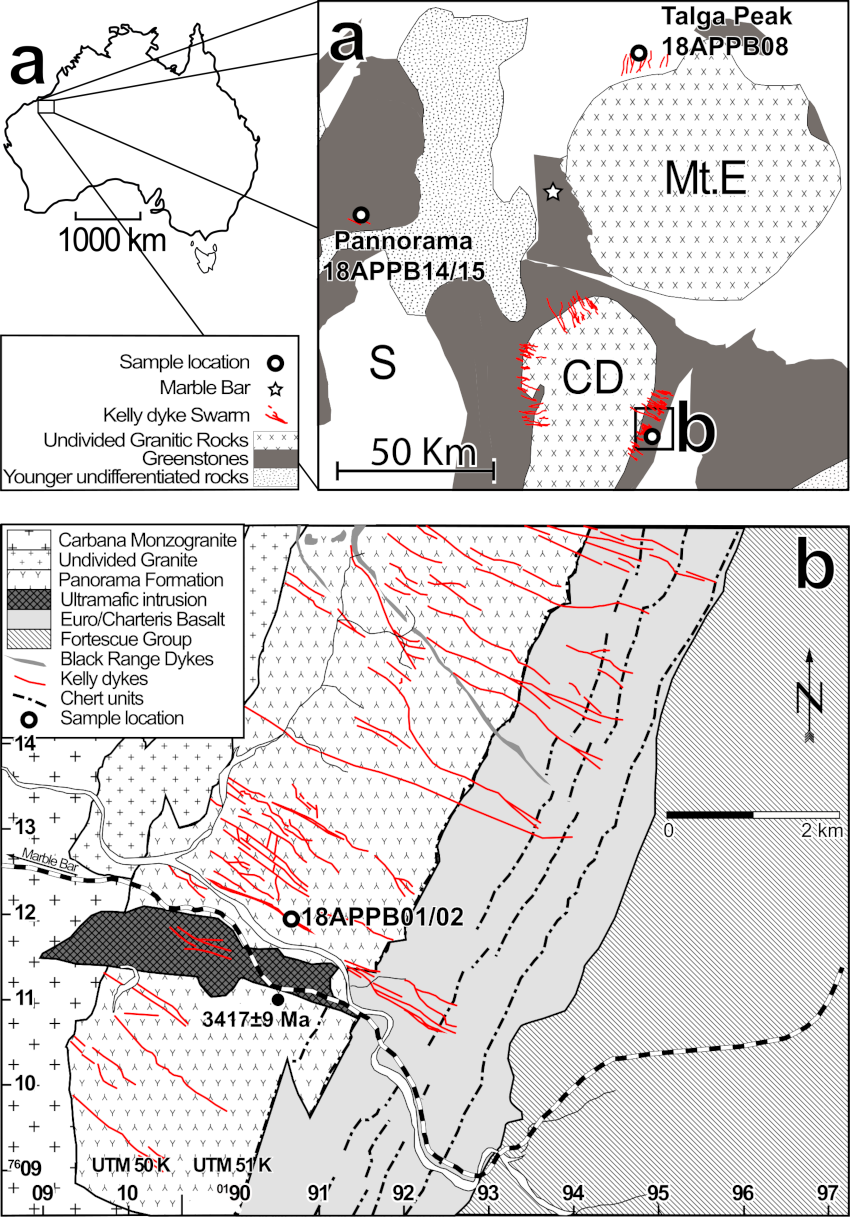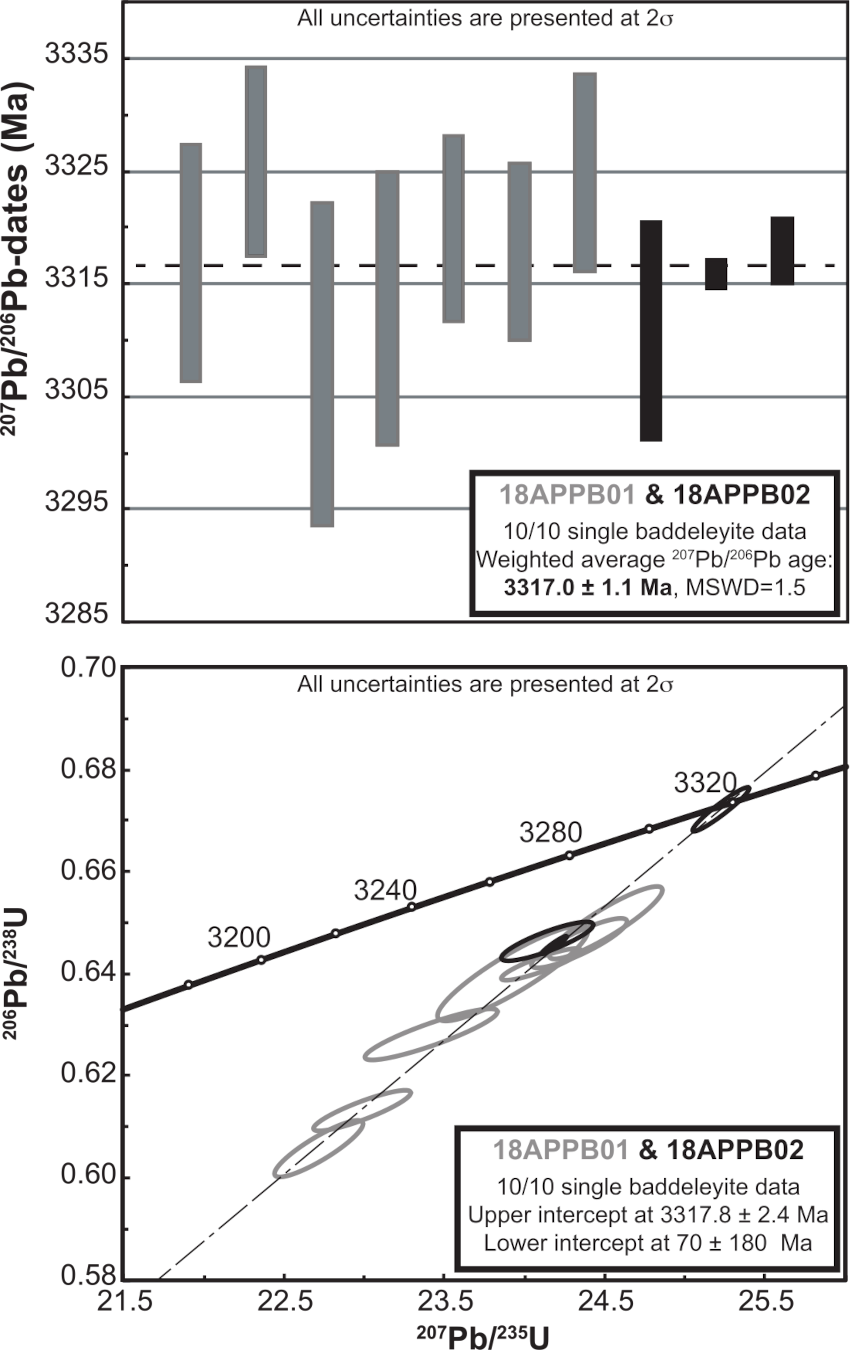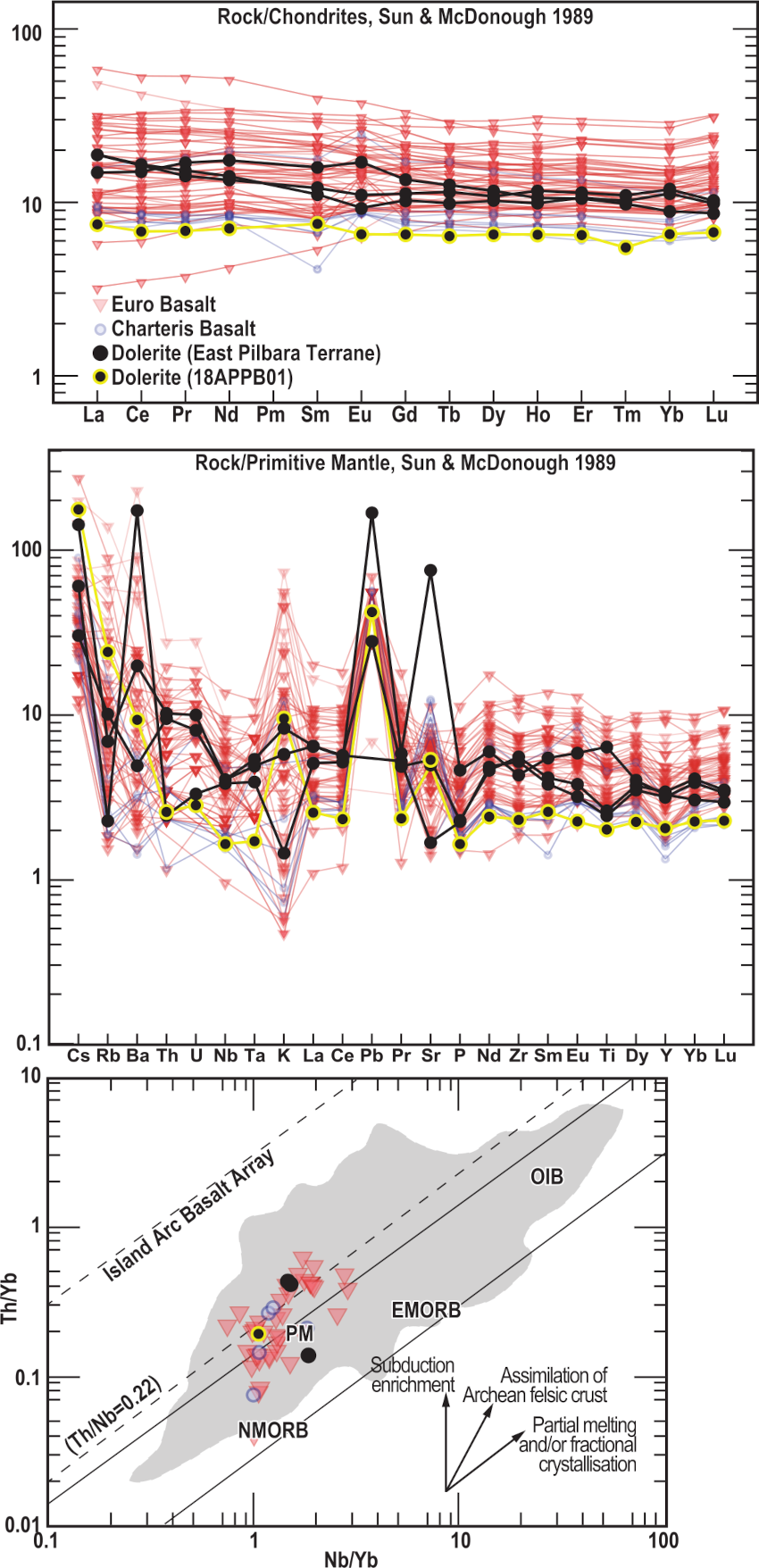2022 October LIP of the Month
The Kelly dyke swarm, Pilbara craton: A 3317 Ma Large Igneous Province?
Andreas Petersson1, Orcid: 0000-0002-0533-1162, Anthony I.S. Kemp2, Orcid: 0000-0003-1642-0360, Steven W. Denyszyn2,3, Orcid: 0000-0001-5141-9694;
1 Department of Geosciences and Natural Resource Management (Geology Section), University of Copenhagen, Øster Voldgade 10, 1350 Copenhagen K, Denmark; email: ape@ign.ku.dk
2 School of Earth Sciences, The University of Western Australia, Perth, Australia
3 Department of Earth Sciences, Memorial University of Newfoundland, St. John's, NL A1B 3X5, Canada
Extracted from, and for full details, see: Petersson et al.. (2022)
A. Petersson, A. I. S. Kemp & S. W. Denyszyn (2022) The Kelly Dyke swarm, Pilbara Craton: a 3317 Ma large igneous province?, Australian Journal of Earth Sciences, DOI: 10.1080/08120099.2023.2126007
Abstract
While the onset of plate tectonics has been proposed as far back in time as the Hadean, the Pilbara Craton and the majority of other Archean cratons do not show evidence of rigid crust that can support linear dyke swarms until around 2701 Ma and 2500 Ma, respectively. Here, we present a precise 3317.0 ± 1.1 Ma baddeleyite U-Pb ID-TIMS age determination for a dolerite from a regionally extensive dyke swarm beneath the Euro Basalt in the East Pilbara Terrane. These results have links to the Kaapvaal Craton and show that the dolerite is a component of what may be the oldest Large Igneous Provinces (LIP) on Earth. Based on the brittle fractures that allowed the dyke swarm to be emplaced, and the thick sequence of mafic to ultramafic lavas that overlay the dolerite dykes, we relate this event to the deposition of a large volcano-sedimentary basin. This is the first time a dyke swarm has been utilized as proof of solid crust before 3000 Ma, indicating that there were lithospheric conditions suitable for plate tectonics at least as far back as the Paleoarchean.
Introduction
Figure 1 depicts the Paleoarchean history of the Pilbara Craton in Western Australia. From 3420 Ma to 3220 Ma, numerous, large granitic bodies, primarily of the composition tonalite-trondhjemite-granodiorite (TTG), were deposited into the continental crust, which was partially formed at around 3600 Ma (e.g., Petersson et al. 2019b, 2020). The Pilbara Supergroup, also known as the Warrawoona, Kelly, and Sulphur Springs volcano-sedimentary groups, are three volcanic-sedimentary groups that border and overlie eleven significant granitic complexes in the East Pilbara Terrane (Van Kranendonk et al., 2002). The dome and keel pattern of Archean granite-greenstone terranes is modelled by these characteristics of the East Pilbara Terrane (Van Kranendonk et al., 2007). The Pilbara Craton also documents the emplacement of volumetrically massive mafic magmas, which are preserved as mafic dyke swarms that have been exposed by erosion and as thick packages of mafic-to-ultramafic volcanic rocks. Indicative of a Neoarchean shift to a more rigid, stable crust, this is similar to several Archean cratons (such as Yilgarn, Zimbabwe, Superior, Kola-Karelia), which also record the emplacement of dyke swarms throughout the late Neoarchean and early Paleoproterozoic (Cawood et al., 2018). The timing of these early dyke swarms is important in determining the presence of stiff continental lithosphere that can sustain the brittle fracture caused by the emplacement of linear dykes.

Fig. 1. Space-time chart outlining the evolution of the exposed East Pilbara Terrane (modified after Hickman et al., 2010; Petersson et al., 2020). The stratigraphic positions of the sample analysed in this study are indicated by a red star symbol.
The Pilbara Craton's East Pilbara Terrane (Figure 1, 2) is home to the 15 km thick 3530-3430 Ma Warrawoona Group. This mostly basaltic series may be the Earth's earliest large igneous province (LIP) (Hickman, 2012, 2021). While its small geographic extent and extended eruptive history could argue against this designation (e.g., Bryan & Ernst, 2008; Ernst, 2014) it is possible that it originally extended onto other, formerly adjacent, crustal blocks. A significant dyke swarm, initially found 55 kilometres south of Marble Bar (Kloppenburg, 2003), consists of densely spaced and generally well-preserved dolerite, gabbro, and peridotite dykes beneath the Pilbara Craton's thickest basaltic deposit, the Euro Basalt of the Kelly Group (Figure 1). These dykes cut through felsic volcanic rocks from the Panorama Formation (ca. 3430 Ma) (Petersson et al., 2020). We report a robust baddeleyite U-Pb age and whole rock geochemistry from dolerite dykes of the Kelly Group at three locations >70 km apart (Figure 1), as well as geochemistry from related dolerites of the Marble Bar area. This constrains the age of this dyke swarm and further investigates the inference of a >3000 Ma LIP in rigid crust in the Pilbara Craton. We identify a large dyke swarm at >3300 Ma and investigate the potential of a Paleoarchean LIP that connected at least two of Earth's first continents, Pilbara and Kaapvaal cratons.

Fig. 2. Simplified map of the sample localities (A). Sample 18APPB08, Lat: -20.925834°, Long: 119.943449°. Sample 18APPB14, Lat: -21.260931°, Long: 119.401135°, and sample 18APPB15, Lat: -21.260143°, Long: 119.403232°. Mt.E = Mount Edgar Granite Complex, S = Shaw Granite Complex and CD = Corunna Downs Granite Complex. Lower map (B) showing Kelly dyke type locality, with the more exact location, and the main geological features surrounding, samples 18APPB01, Lat: -21.566549°, Long: 120.011589° and sample 18APPB02, Lat: -21.566919°, Long: 120.012614°. Map B, is based on Kloppenburg, (2003).
Samples
Samples 18APPB01 and 18APPB02 are coarse-grained, hornblende-bearing ophitic to sub-ophitic dolerites, collected ~100 meters apart along a ~15 m wide dyke with an ESE–WNW strike of 104° and subvertical dip (Fig. 2). Sample 18APPB08, from the Talga Peak area northeast of Marble Bar, is a fine-grained N-S-trending dolerite with interlocking plagioclase and pyroxenes, small pyrite grains and a slightly green color due to epidote (Fig. 2). Samples 18APPB14 and 18APPB15 are from two ~10-metre-wide, coarse-grained dolerite dykes just north of the Panorama Formation type locality (Fig.2, Petersson et al. 2019a).
Discussion
Our Kelly dyke age of 3317 ± 1 Ma provides a minimum age for the Euro basalt, which consists of a widespread 1.5 km thickness of komatiite and a 5 km thickness of overlaying komatiitic and tholeiitic basalt (Fig. 3; Van Kranendonk et al., 2007). The identical geochronology and lithology imply a link with the Kromberg Formation of the Onverwacht Group, assuming a paleocontinental layout with the Pilbara and Kaapvaal Cratons growing next to each other, where a link of this type would increase the area of the Euro basalt to at least 1 000 000 km2 (see Hickman, 2021). As shown in Figure 4, the Kelly dyke swarm dolerites have overall primitive geochemical signatures that overlap with those of the Charteris Basalts and the most primitive samples of the Euro Basalt. The Euro and Charteris Basalts account for a considerable portion of the volcanic strata in the East Pilbara Terrane (13 km), and this prospective LIP necessitates a large network of magmatic conduits. Due to the fact that the Kelly dyke swarm has comparable geochemical fingerprints and age to the Charteris and Euro basalts, it is thought to represent the magmatic plumbing system for these lavas. Furthermore, the temporal association with the nearby 3313 ± 9 Ma Carbana Pool monzogranite (Figure 1) and the coeval felsic volcanic Wyman Formation, implies a fully-differentiated igneous suite of intrusive and extrusive mafic and felsic rocks that collectively represent the geological record's oldest (sensu stricto) Large Igneous Province. All of the requirements for a rigid lithosphere as defined by Cawood et al., (2018) - brittle structures, dyke swarms, and large-scale sedimentary basins - are identified in the Pilbara Craton between 3430 and 3320 Ma. Rigid crust is required for horizontal tectonics and is most likely a condition for the formation of thick basaltic crust and LIPs. A rigid lithosphere is also necessary for permitting thick basaltic crust to form, which may then re-melt to yield felsic magmas, boosting the stability of the proto-cratonic crust at this period.

Fig. 3. A combined U–Pb dataset of baddeleyite from samples 18APPB01 (grey) and 18APPB02 (black), sampling the same dolerite dyke at different locations. Upper panel shows the weighted average 207Pb/206Pb age of 10 single grain baddeleyite data. Lower panel shows the Wetherill Concordia plot of the same 10 data points. All data are presented at 2s.

Fig. 4. Chondrite-normalized REE patterns (upper panel) and primitive mantle-normalized trace element patterns (mid panel) comparing all sampled dykes to the Euro and Charteris basalts (data from Smithies et al., 2007). Note the depleted signatures of the dolerites and the close similarities to the Charteris Basalt samples, in particular. The lower panel shows all samples plotted in Th/Yb versus Nb/Yb space. All samples have Th/Nb<0.3 and only minor amounts of crustal contamination is indicated. Importantly, the dolerite samples overlap the field of the Euro and Charteris basalts. The grey filed in the lower panel shows the compositions of continental LIPs, from Pearce et al., (2021). All chondrite and mantle reservoir normalising values are from Sun and McDonough, (1989). Lower plot modified after Pearce et al., (2021).
References
Bryan S. E. & Ernst R. E., 2008. Revised definition of large igneous provinces (LIPs). Earth-Science Reviews, 86(1–4), 175–202. https://doi.org/10.1016/j.earscirev.2007.08.008
Cawood P. A., Hawkesworth C. J., Pisarevsky S. A., Dhuime B., Capitanio F. A. & Nebel O. 2018. Geological archive of the onset of plate tectonics. Philosophical Transactions of the Royal Society A: Mathematical, Physical and Engineering Sciences 376(2132), 20170405. https://doi.org/10.1098/rsta.2017.0405
Ernst R. E. (2014) Large Igneous Provinces. Cambridge University Press, 653 p.
Hickman A. H., Smithies R. H. & Tyler I. M. Record 2010/3., 2010. Evolution of Active Plate Margins: West Pilbara Superterrane, De Grey Superbasin, and the Fortescue and Hamersley Basins – A Field Guide. Geological Survey of Western Australia 74.
Hickman A. H. 2012. Review of the Pilbara Craton and Fortescue Basin, Western Australia: Crustal evolution providing environments for early life. Island Arc 21(1), 1–31. https://doi.org/10.1111/j.1440-1738.2011.00783.x
Hickman A. H. 2021. East Pilbara Craton: a record of one billion years in the growth of Archean continental crust. Geological Survey of Western Australia, Report 143, 1–187.
Kloppenburg A. 2003. Structural evolution of the Marble Bar Domain, Pilbara granite-greenstone terrain, Australia: the role of Archaean mid-crustal detachments. Geologica Ultraiectina 237, Doctoral dissertation, Departement Aardwetenschappen.
Pearce J. Ernst R.E., Peate D. & Rogers C. 2021. LIP Printing: Use of Immobile Element Proxies to Characterize Large Igneous Provinces in the Geologic Record. Lithos 392,106068. https://doi.org/10.1016/j.lithos.2021.106068
Petersson A., Kemp A. I. & Whitehouse M. J. 2019a. A Yilgarn seed to the Pilbara Craton (Australia)? Evidence from inherited zircons. Geology 47(11), 1098–1102. https://doi.org/10.1130/G46696.1
Petersson A., Kemp A. I., Hickman A. H., Whitehouse M. J., Martin L. & Gray C. M. 2019b. A new 3.59 Ga magmatic suite and a chondritic source to the east Pilbara Craton. Chemical Geology 511, 51–70. https://doi.org/10.1016/j.chemgeo.2019.01.021
Petersson A., Kemp A. I., Gray C. M. & Whitehouse M. J. 2020. Formation of early Archean Granite-Greenstone Terranes from a globally chondritic mantle: Insights from igneous rocks of the Pilbara Craton, Western Australia. Chemical Geology 551, 119757. https://doi.org/10.1016/j.chemgeo.2020.119757
Petersson, A., A.I.S., & Denyszyn, S.W. 2022. The Kelly Dyke swarm, Pilbara Craton: a 3317 Ma large igneous province?, Australian Journal of Earth Sciences, DOI: 10.1080/08120099.2023.2126007
Sun S. S. & McDonough W. F. 1989. Chemical and isotopic systematics of oceanic basalts: implications for mantle composition and processes. Geological Society, London, Special Publications 42(1), 313–345. https://doi.org/10.1144/GSL.SP.1989.042.01.19
Van Kranendonk M. J., Hickman A. H., Smithies R. H., Nelson D. R. & Pike G. 2002. Geology and tectonic evolution of the archean North Pilbara terrain, Pilbara Craton, Western Australia. Economic Geology 97(4), 695–732. https://doi.org/10.2113/gsecongeo.97.4.695
Van Kranendonk M. J., Smithies R. H., Hickman A. H. & Champion D. C. 2007. Paleoarchean development of a continental nucleus: the East Pilbara terrane of the Pilbara Craton, Western Australia. Developments in Precambrian Geology 15, 307–337. https://doi.org/10.1016/S0166-2635(07)15041-6
